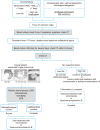Advances in prophylaxis and treatment of invasive fungal infections: perspectives on hematologic diseases
- PMID: 35483934
- PMCID: PMC9057668
- DOI: 10.5045/br.2022.2022036
Advances in prophylaxis and treatment of invasive fungal infections: perspectives on hematologic diseases
Abstract
Invasive fungal infections (IFIs) are common causes of mortality and morbidity in patients with hematologic diseases. Delayed initiation of antifungal treatment is related to mortality. Aspergillus sp. is the leading cause of IFI followed by Candida sp. Diagnosis is often challenging owing to variable conditions related to underlying diseases. Clinical suspect and prompt management is important. Imaging, biopsy, and non-culture-based tests must be considered together. New diagnostic procedures have been improved, including antigen-based assays and molecular detection of fungal DNA. Among hematologic diseases, patients with acute myeloid leukemia, myelodysplastic syndrome, recipients of hematopoietic stem cell transplantation are at high risk for IFIs. Antifungal prophylaxis is recommended for these high-risk patients. There are continuous attempts to achieve ideal management of IFIs. Scoring system for quality control has been developed with important recommendations of current guidelines. Higher adherence to guidelines is related to decreased mortality in IFIs.
Keywords: Diagnosis; Hematologic diseases; Invasive fungal infections; Quality control; Treatment.
Conflict of interest statement
No potential conflicts of interest relevant to this article were reported.
Figures

Similar articles
-
Management of Invasive Fungal Infections in Patients Undergoing Allogeneic Hematopoietic Stem Cell Transplantation: The Turin Experience.Front Cell Infect Microbiol. 2022 Jan 7;11:805514. doi: 10.3389/fcimb.2021.805514. eCollection 2021. Front Cell Infect Microbiol. 2022. PMID: 35071052 Free PMC article.
-
Randomized trial of micafungin versus fluconazole as prophylaxis against invasive fungal infections in hematopoietic stem cell transplant recipients.J Infect. 2016 Nov;73(5):496-505. doi: 10.1016/j.jinf.2016.06.011. Epub 2016 Jul 7. J Infect. 2016. PMID: 27394404 Clinical Trial.
-
Breakthrough Invasive Fungal Infections in Patients with Acute Myeloid Leukemia.Mycopathologia. 2020 Apr;185(2):299-306. doi: 10.1007/s11046-019-00418-8. Epub 2020 Jan 14. Mycopathologia. 2020. PMID: 31939052
-
Patients at high risk of invasive fungal infections: when and how to treat.Drugs. 2008;68(14):1941-62. doi: 10.2165/00003495-200868140-00002. Drugs. 2008. PMID: 18778118 Review.
-
Approaches to the management of invasive fungal infections in hematologic malignancy and hematopoietic cell transplantation.J Clin Oncol. 2009 Jul 10;27(20):3398-409. doi: 10.1200/JCO.2008.20.1178. Epub 2009 Jun 1. J Clin Oncol. 2009. PMID: 19487382 Review.
Cited by
-
IFISTRATEGY: Spanish National Survey of Invasive Fungal Infection in Hemato-Oncologic Patients.J Fungi (Basel). 2023 May 30;9(6):628. doi: 10.3390/jof9060628. J Fungi (Basel). 2023. PMID: 37367564 Free PMC article.
-
Dynamic changes in physical function during intensive chemotherapy affect transplant outcomes in older adults with AML.Front Oncol. 2023 Nov 7;13:1281782. doi: 10.3389/fonc.2023.1281782. eCollection 2023. Front Oncol. 2023. PMID: 38023260 Free PMC article.
-
Antifungal Stewardship in Invasive Fungal Infections, a Systematic Review.Adv Exp Med Biol. 2025;1476:49-68. doi: 10.1007/5584_2024_798. Adv Exp Med Biol. 2025. PMID: 38337088
-
Successful Treatment of Rare Pulmonary Coprinopsis cinerea Infection in a 17-Year-Old Female After Hematopoietic Stem Cell Transplantation: A Case Report.Infect Drug Resist. 2023 Mar 18;16:1567-1572. doi: 10.2147/IDR.S397233. eCollection 2023. Infect Drug Resist. 2023. PMID: 36969940 Free PMC article.
-
Epidemiology and Characteristics of Invasive Yeast Infections in Patients with Hematologic Diseases: 12-Year Single-Center Retrospective Cohort Study.J Fungi (Basel). 2025 Aug 8;11(8):585. doi: 10.3390/jof11080585. J Fungi (Basel). 2025. PMID: 40863537 Free PMC article.
References
-
- Edwards JE., Jr. Diagnosis and treatment of fungal infections. In: Jameson JL, Fauci A, Kasper D, Hauser S, Longo D, Loscalzo J, eds. Harrison's principles of internal medicine. 20th ed. New York, NY: McGraw-Hill Education, 2018:1515–38.
-
- Shin JH, Won EJ, Kim SH, et al. A multicenter study of antifungal use and species distribution and antifungal susceptibilities of candida isolates in South Korea. J Mycol Infect. 2020;25:10–6. doi: 10.17966/JMI.2020.25.1.10. - DOI
Publication types
LinkOut - more resources
Full Text Sources

